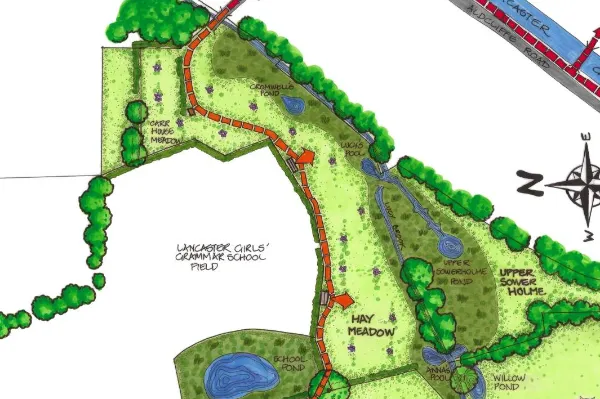Hay Meadow
The Hay Meadow is about 1 ha (approx. 2.5 acres) on the left of the path entering the reserve from Cromwell Rd.
History
- The Fauna path was put in by the Fairfield Association when it took over the lease in 2011.
- Before then it would have looked very different with a single large field, covering what is now the Grammar School Field on the hill, Big Meadow, the Hay Meadow and Carr House Meadow. The area was grazed by cattle.
- It was used by Dallas Rd. and St. Peters primary schools as playing fields, with cricket higher up, and football further down towards the brook. Before playing, the children tried to scrape up cow pats but didn’t succeed in getting them all!
Since 2012
- We started managing the hay meadow as a wildflower meadow by spreading “green hay”, (hay which contains a variety of species of grass and wildflowers), donated by the Lancashire Wildlife Trust from their reserve at Heysham
- Three ponds were created: Cromwell’s Pond which is visible from the path and the smaller Anna’s and Lucy’s Ponds in the wetter area near the brook.
- Cromwell’s Pond was improved by Lancashire Wildlife Trust as part of their Great Crested Newt initiative in 2021.
Current Features
- In the spring and summer, the meadow is covered in wildflowers such as yellow rattle, meadow buttercup, red clover and knapweed.
- The presence of yellow rattle is important as it feeds off the roots of grass, weakening it and allowing broad-leaved plants to develop.
- The damp area near Cromwell Rd. has a mixture of grass and rush (juncus) with some bramble and self-seeded saplings of willow and silver birch.
- Cromwell’s Pond has not attracted great crested newts but it is valuable for other pond life including dragon flies.
- There is a line of venerable old willow trees by Lucy Brook.
Maintenance
- The cattle are kept out of the meadow from April 1st to late summer to allow the wildflowers to grow.
- The meadow is either cut for hay in late July or August, or the cattle “graze it off”.
- Ragwort, which is injurious to cattle if mixed in with the hay, is dug out. (Cattle avoid it when grazing).
- Paths are created in the rush in the damp area either by scything or by the cattle, helping to create a more diverse habitat and conditions which are favoured by snipe.
Future
- The damp area may be allowed to develop into a “carr” or wet woodland.
Photographic Survey
The Fairfield Association have maintained a photographic survey of the reserve since 2015. Photographs have been taken on roughly 5 occasions each year: March, mid-May, late June, early August and late September.
Each album is arranged in date order. To find out the specific date particular photos were taken, first select the photo and then select the ‘i’ icon in the top-right of screen. (All albums launch in a new window.)





